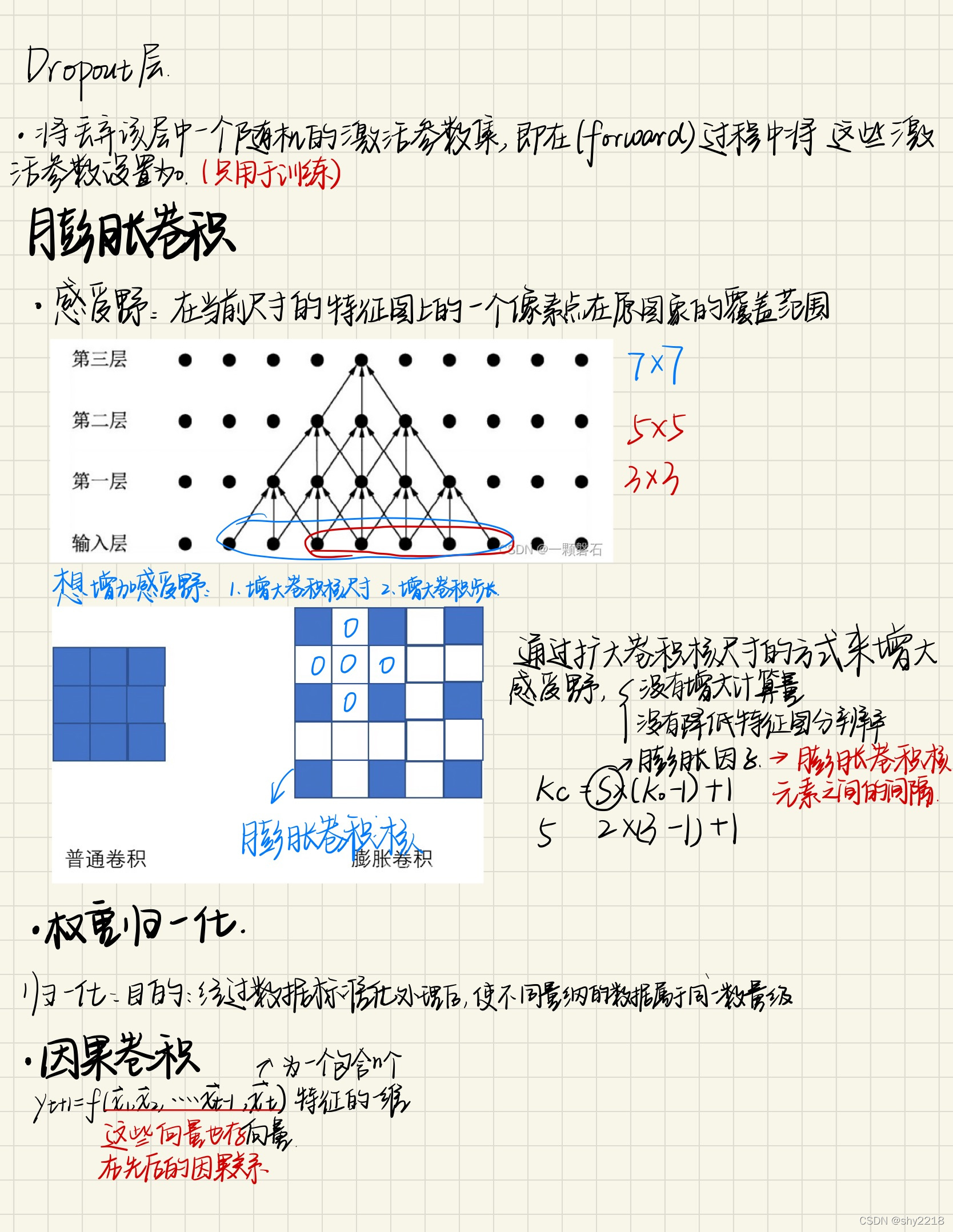Pytorch相关
- torch的核心是Module类,pytorch中其实一般没有特别明显的Layer和Module的区别,不管是自定义层、自定义块、自定义模型,都是通过继承Module类完成的,这一点很重要。其实Sequential类也是继承自Module类的。
- pytorch里面一般是没有层的概念,层也是当成一个模型来处理的
Sequential类
参考:https://blog.youkuaiyun.com/qq_27825451/article/details/90551513
class Sequential(Module): # 继承Module
def __init__(self, *args): # 重写了构造函数
def _get_item_by_idx(self, iterator, idx):
def __getitem__(self, idx):
def __setitem__(self, idx, module):
def __delitem__(self, idx):
def __len__(self):
def __dir__(self):
def forward(self, input): # 重写关键方法forward
#除了Sequential类以外 的容器
class Container(Module):
class Sequential(Module):
class ModuleList(Module):
class ModuleDict(Module):
class ParameterList(Module):
class ParameterDict(Module):
使用Sequential创建网络
import torch.nn as nn
model = nn.Sequential(
nn.Conv2d(1,20,5),
nn.ReLU(),
nn.Conv2d(20,64,5),
nn.ReLU()
)
print(model)
print(model[2]) # 通过索引获取第几个层
'''运行结果为:
Sequential(
(0): Conv2d(1, 20, kernel_size=(5, 5), stride=(1, 1))
(1): ReLU()
(2): Conv2d(20, 64, kernel_size=(5, 5), stride=(1, 1))
(3): ReLU()
)
Conv2d(20, 64, kernel_size=(5, 5), stride=(1, 1))
'''
使用Sequential来包装层
import torch.nn as nn
from collections import OrderedDict
class MyNet(nn.Module):
def __init__(self):
super(MyNet, self).__init__()
self.conv_block = nn.Sequential(
nn.Conv2d(3, 32, 3, 1, 1),
nn.ReLU(),
nn.MaxPool2d(2))
self.dense_block = nn.Sequential(
nn.Linear(32 * 3 * 3, 128),
nn.ReLU(),
nn.Linear(128, 10)
)
# 在这里实现层之间的连接关系,其实就是所谓的前向传播
def forward(self, x):
conv_out = self.conv_block(x)
res = conv_out.view(conv_out.size(0), -1)
out = self.dense_block(res)
return out
model = MyNet()
print(model)
'''运行结果为:
MyNet(
(conv_block): Sequential(
(0): Conv2d(3, 32, kernel_size=(3, 3), stride=(1, 1), padding=(1, 1))
(1): ReLU()
(2): MaxPool2d(kernel_size=2, stride=2, padding=0, dilation=1, ceil_mode=False)
)
(dense_block): Sequential(
(0): Linear(in_features=288, out_features=128, bias=True)
(1): ReLU()
(2): Linear(in_features=128, out_features=10, bias=True)
)
)
'''
nn.Module类
class Module(object):
def __init__(self):
def forward(self, *input):
def add_module(self, name, module):
def cuda(self, device=None):
def cpu(self):
def __call__(self, *input, **kwargs):
def parameters(self, recurse=True):
def named_parameters(self, prefix='', recurse=True):
def children(self):
def named_children(self):
def modules(self):
def named_modules(self, memo=None, prefix=''):
def train(self, mode=True):
def eval(self):
def zero_grad(self):
def __repr__(self):
def __dir__(self):
'''
有一部分没有完全列出来
'''
我们在定义自已的网络的时候,需要继承nn.Module类,并重新实现构造函数__init__和forward这两个方法。但有一些注意技巧:
(1)一般把网络中具有可学习参数的层(如全连接层、卷积层等)放在构造函数__init__()中。
(2)一般把不具有可学习参数的层(如ReLU、dropout、BatchNormanation层)可放在构造函数中,也可不放在构造函数中,如果不放在构造函数__init__里面,则在forward方法里面可以使用nn.functional来代替
(3)forward方法是必须要重写的,它是实现模型的功能,实现各个层之间的连接关系的核心。
import torch
class MyNet(torch.nn.Module):
def __init__(self):
super(MyNet, self).__init__() # 第一句话,调用父类的构造函数
self.conv1 = torch.nn.Conv2d(3, 32, 3, 1, 1)
self.relu1=torch.nn.ReLU()
self.max_pooling1=torch.nn.MaxPool2d(2,1)
self.conv2 = torch.nn.Conv2d(3, 32, 3, 1, 1)
self.relu2=torch.nn.ReLU()
self.max_pooling2=torch.nn.MaxPool2d(2,1)
self.dense1 = torch.nn.Linear(32 * 3 * 3, 128)
self.dense2 = torch.nn.Linear(128, 10)
def forward(self, x):
x = self.conv1(x)
x = self.relu1(x)
x = self.max_pooling1(x)
x = self.conv2(x)
x = self.relu2(x)
x = self.max_pooling2(x)
x = self.dense1(x)
x = self.dense2(x)
return x
model = MyNet()
print(model)
'''运行结果为:
MyNet(
(conv1): Conv2d(3, 32, kernel_size=(3, 3), stride=(1, 1), padding=(1, 1))
(relu1): ReLU()
(max_pooling1): MaxPool2d(kernel_size=2, stride=1, padding=0, dilation=1, ceil_mode=False)
(conv2): Conv2d(3, 32, kernel_size=(3, 3), stride=(1, 1), padding=(1, 1))
(relu2): ReLU()
(max_pooling2): MaxPool2d(kernel_size=2, stride=1, padding=0, dilation=1, ceil_mode=False)
(dense1): Linear(in_features=288, out_features=128, bias=True)
(dense2): Linear(in_features=128, out_features=10, bias=True)
)
'''
其他小知识
- 卷积层的输出通道数取决于卷积核的数目
- view函数:

- squeeze和unsqueeze
squeeze:主要对数据的维度进行压缩或解压,squeeze(a)就是将a中所有为1的维度删掉。
unsqueeze:给指定位置加上维数为一的维度
VEN
TCN
因果卷积
即对于上一层t时刻的值,只依赖于下一层t时刻及其之前的值。




class TemporalBlock(nn.Module):
def __init__(self, n_inputs, n_outputs, kernel_size, stride, dilation, padding, dropout=0.2):
super(TemporalBlock, self).__init__()
self.conv1 = weight_norm(nn.Conv1d(n_inputs, n_outputs, kernel_size, stride=stride, padding=padding, dilation=dilation))
# self.chomp1 = Chomp1d(padding)
self.relu1 = nn.RReLU()
self.dropout1 = nn.Dropout(dropout)
self.conv2 = weight_norm(nn.Conv1d(n_outputs, n_outputs, kernel_size, stride=stride, padding=padding, dilation=dilation))
# self.chomp2 = Chomp1d(padding)
self.relu2 = nn.RReLU()
self.dropout2 = nn.Dropout(dropout)
# self.net = nn.Sequential(self.conv1, self.chomp1, self.relu1, self.dropout1,
# self.conv2, self.chomp2, self.relu2, self.dropout2)
self.net = nn.Sequential(self.conv1, self.relu1, self.dropout1,
self.conv2, self.relu2, self.dropout2)
self.downsample = nn.Conv1d(n_inputs, n_outputs, 1) if n_inputs != n_outputs else None
self.relu = nn.RReLU()
self.init_weights()
def init_weights(self):
self.conv1.weight.data.normal_(0, 0.01)
self.conv2.weight.data.normal_(0, 0.01)
if self.downsample is not None:
self.downsample.weight.data.normal_(0, 0.01)
def forward(self, x):
out = self.net(x)
res = x if self.downsample is None else self.downsample(x)
return self.relu(out + res)
class TemporalConvNet(nn.Module):
def __init__(self, num_inputs, num_channels, kernel_size=2, dropout=0.2):
super(TemporalConvNet, self).__init__()
layers = []
num_levels = len(num_channels)
for i in range(num_levels):
dilation_size = 2 ** i
in_channels = num_inputs if i == 0 else num_channels[i - 1]
out_channels = num_channels[i]
layers += [TemporalBlock(in_channels, out_channels, kernel_size, stride=1, dilation=dilation_size,
padding=int((kernel_size - 1) * dilation_size / 2), dropout=dropout)]
self.network = nn.Sequential(*layers)
def forward(self, x):
return self.network(x)
class VideoModule(nn.Module):
def __init__(self):
super(VideoModule, self).__init__()
self.tcn = TemporalConvNet(LEN_FEATURE_V, [2048, 1024, 512, 256], kernel_size=3, dropout=DROP_OUT)
self.conv1d = nn.ModuleList([nn.Conv1d(in_channels=256,
out_channels=256,
kernel_size=kernel_size,
stride=stride,
dilation=1)# 这里创建了一个输入单元为256 输出单元为256的1维卷积网络
for stride, kernel_size in zip(STRIDE, KERNEL_SIZE)])
self.net = nn.Sequential(
nn.RReLU(),
nn.Linear(256, LEN_FEATURE_B),
nn.RReLU(),
nn.Linear(LEN_FEATURE_B, LEN_FEATURE_B)
)
def forward(self, feed):
feed = self.tcn(feed)
out = []
for kernel_size, conv1d in zip(KERNEL_SIZE, self.conv1d):
if feed.shape[2] >= kernel_size:
tmp = conv1d(feed)
out.append(tmp)
out = torch.cat(out, dim=2).permute(0, 2, 1)
out = torch.squeeze(out, dim=0)
out = self.net(out)
return out
QEN
三层全连接网络
class SentenceModule(nn.Module):
def __init__(self):
super(SentenceModule, self).__init__()
self.net = nn.Sequential(
##三层全连接网络
nn.Linear(LEN_FEATURE_S, 512),#对传入数据应用线性变换:y = A x+ b
nn.RReLU(),
nn.Linear(512, 256),
nn.RReLU(),
nn.Linear(256, LEN_FEATURE_B)
)
def forward(self, feed):
out = self.net(feed)
return out
























 1万+
1万+

 被折叠的 条评论
为什么被折叠?
被折叠的 条评论
为什么被折叠?








